Crabgrass:
 Crabgrass
tops America's
list of lawn
complaints. A
fast-growing
annual that
reproduces by
seeds and by
rooting at the
lower joints.
This weed
appears from
mid-spring
through summer
when the ground
is warm. It
grows well under
dry, hot
conditions. Go
after crabgrass
as soon as it
appears in the
garden. Dig it
out by the roots
with a spading
fork or cover it
with black
plastic. Dont
let it go to
seed.
Crabgrass
tops America's
list of lawn
complaints. A
fast-growing
annual that
reproduces by
seeds and by
rooting at the
lower joints.
This weed
appears from
mid-spring
through summer
when the ground
is warm. It
grows well under
dry, hot
conditions. Go
after crabgrass
as soon as it
appears in the
garden. Dig it
out by the roots
with a spading
fork or cover it
with black
plastic. Dont
let it go to
seed.
To prevent crabgrass in the future, attack the problem in two stages. In the early spring, apply corn gluten meal, an organic preemergent herbicide. Spring is when the soil is cold and the crabgrass is weakest. (Crabgrass is an annual weed, so it starts from seed every year. The preemergent herbicide prevents the seed from germinating--and if the seed can't sprout, it can't grow.) Second, re-seed your lawn in the fall. This will allow the new grass time to grow strong before the next summer's attack.
The best crabgrass preventer is a healthy, thick lawn, and soil with the proper pH balance (7.0-7.5). Perennial ryegrass is the best competition for crabgrass. It also provides some insect control, as it emits a natural poison that gives some small, damaging bugs the "flu." Fertilizing is key and must be done in the spring and in the fall. Crabgrass thrives in compacted lawns. Aeration can help. A mixture of 1 pint of hydrogen peroxide, diluted to 3 percent, per 100 square feet of lawn can help eradicate the pesky plant. Click image to enlarge.
Pigweed:
 An
annual that
reproduces by
seeds. It is
characterized by
its fleshly, red
taproot. This
weeds appears in
late spring or
early summer and
likes warm
weather. Try to
pull out this
weed before it
flowers.
An
annual that
reproduces by
seeds. It is
characterized by
its fleshly, red
taproot. This
weeds appears in
late spring or
early summer and
likes warm
weather. Try to
pull out this
weed before it
flowers.
To prevent weeds in the future, cover your garden plot with a winter mulch, then till the garden shallowly in early spring. When you till you may bring up some pigweed seed so it's best to mulch again. Cover the soil with five layers of wet newspaper and cover that with 3-6 inches of mulch.
Pigweed can also be eaten! In June, the young leaves of Amaranthus blitum or amaranth are abundant and should be eaten because of their high nutritional content. Vitamin-wise, these greens are packed like carrots and beets and can be delicious in a tossed salad. You can also cook them as you would spinach. Native Americans used the black seeds of this plant as a ground meal for baking. Click image to see more.
Chickweed
 There
are two species
of chickweed,
one perennial
and one annual.
Mouse-ear
chickweed is the
perennial, which
forms a dense,
prostrate patch
in lawns and
gardens. Common
chickweed, the
annual, is more
delicate in
appearance, with
leaves that are
broad at the
base and about
half an inch
long.
There
are two species
of chickweed,
one perennial
and one annual.
Mouse-ear
chickweed is the
perennial, which
forms a dense,
prostrate patch
in lawns and
gardens. Common
chickweed, the
annual, is more
delicate in
appearance, with
leaves that are
broad at the
base and about
half an inch
long.
Common chickweed is easier to control. Both types have shallow roots, so they can often be removed by hoeing or hand-pulling. New plants can grow from broken pieces of mouse-ear rootstock, however, so make sure you remove the entire plant when using either method.
A healthy lawn can compete against mouse-ear chickweed if the grass is not mowed too short or too frequently. Watering the lawn deeply and infrequently will encourage the grass to grow deeper roots, which also can help it compete against chickweed. Water once every seven to ten days, and apply enough water so that it soaks six to eight inches into the ground.
If you choose to remove chickweed, do it before the weed has time to go to seed, thereby preventing future problems in your garden area. Click image to expand.
Morning
Glory:
A
common annual
that reproduces
by seeds and by
deep, horizontal
roots. This
flowering vine
sprouts in late
spring and can
be seen
throughout the
summer. This
plant can become
a big problem in
warm weather.
Try to dig out
this weed before
it flowers.
Click
image to see
more.
Quackgrass:
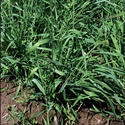 A
creeping,
persistent
perennial that
reproduces by
seeds. Its long,
jointed,
straw-colored
rhizomes form a
heavy mat in
soil, from which
new shoots may
also appear. Try
to dig out this
weed as soon as
you see it in
your garden.
Click
image to enlarge.
A
creeping,
persistent
perennial that
reproduces by
seeds. Its long,
jointed,
straw-colored
rhizomes form a
heavy mat in
soil, from which
new shoots may
also appear. Try
to dig out this
weed as soon as
you see it in
your garden.
Click
image to enlarge.
Lambsquarters:
A
fast-growing
annual that
reproduces by
seeds. This
summer weed
rapidly removes
moisture from
soil, so remove
it as soon as
possible.
Cultivate this
weed out of your
garden using a
sharp hoe.
Click
image to see
more.
Purslane:
An annual that
reproduces by
tiny black seeds
and stem
fragments. This
weed appears in
late spring or
early summer and
likes warm
weather and
rich, fertile
soil. Pull or
cultivate out
this weed as
soon as you see
it and destroy
the plant; this
weed can live in
your soil for
years.
Click image for
a closer look.
Shepherd's
Purse:
 A
flowering annual
that reproduces
by seeds. It
likes cool
weather and its
yellowish-brown
seeds are
long-lived in
the ground. Try
to pull out this
weed before it
seeds.
Click image for
a closer look.
A
flowering annual
that reproduces
by seeds. It
likes cool
weather and its
yellowish-brown
seeds are
long-lived in
the ground. Try
to pull out this
weed before it
seeds.
Click image for
a closer look.
Buckhorn
Plantain:
 A
hardy perennial
that reproduces
by seeds. This
narrow-leaved
weed invades
meadows,
pastures, and
lawns. This weed
appears in any
season. Hand
weed this plant
and destroy it
to remove it
from your
garden.
Click image to
enlarge.
A
hardy perennial
that reproduces
by seeds. This
narrow-leaved
weed invades
meadows,
pastures, and
lawns. This weed
appears in any
season. Hand
weed this plant
and destroy it
to remove it
from your
garden.
Click image to
enlarge.
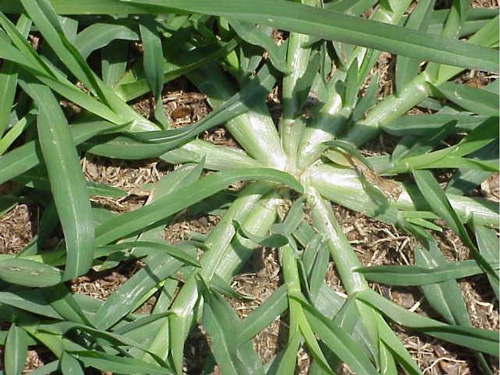
.jpg) kyllinga
sedge
kyllinga
sedge
 nutsedge
nutsedge Crabgrass - Digitaria sp.
Several species that are true
annuals. Peak germination by early
summer. Yellow green leaves rolled
in the bud with hairy edges, coarse
textured, broad collar, membranous
liguile and hairy sheath. Blade flat
with sharp point. Seed head composed
of three to ten finger like racemes
or spikes, may appear purple to tan
in color. Plant declines after
seeding with shorter days.
Eliminated by frost. Occurs all over
the U.S., although less in the North
than the South. Mostly in full sun.
Crabgrass - Digitaria sp.
Several species that are true
annuals. Peak germination by early
summer. Yellow green leaves rolled
in the bud with hairy edges, coarse
textured, broad collar, membranous
liguile and hairy sheath. Blade flat
with sharp point. Seed head composed
of three to ten finger like racemes
or spikes, may appear purple to tan
in color. Plant declines after
seeding with shorter days.
Eliminated by frost. Occurs all over
the U.S., although less in the North
than the South. Mostly in full sun.
 Alexander
grass
Alexander
grass 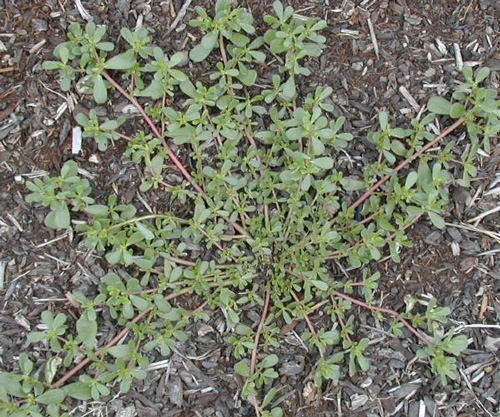 Spurge
- Euphorbia maculate &
E. supine A summer annual
that begins germination from
seed when soil temperatures
reach 85° F and continues all
summer long. Small, oval,
opposite leaves vary from dark
green to red with a brown blotch
on the upper surface. Reddish
low growing stems, that fan out
from the tap root, form a dense
mat. Milky sap is sticky.
Prolific seed producer, several
thousand from one plant. Plant
matures in a matter of days in
hot weather.
Spurge
- Euphorbia maculate &
E. supine A summer annual
that begins germination from
seed when soil temperatures
reach 85° F and continues all
summer long. Small, oval,
opposite leaves vary from dark
green to red with a brown blotch
on the upper surface. Reddish
low growing stems, that fan out
from the tap root, form a dense
mat. Milky sap is sticky.
Prolific seed producer, several
thousand from one plant. Plant
matures in a matter of days in
hot weather.
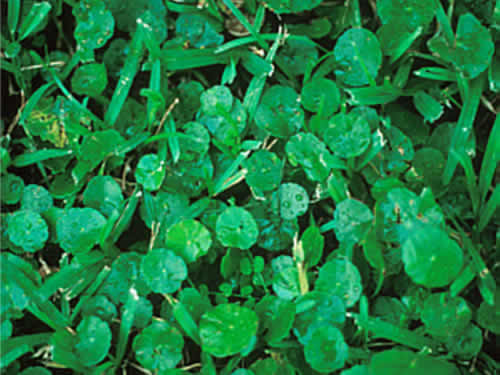 dollarweed
dollarweed

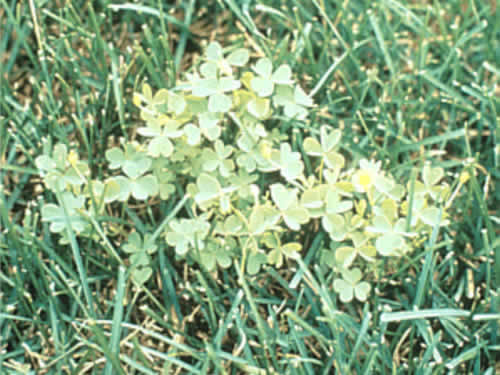 oxalis
oxalis Pusley
..Florida pusley is a summer
annual found most often in warm
season turfgrass areas. The
leaves can be hairy and are grow
opposite one another on hairy
stems. The growth of Florida
pusley in maintained turf areas
is usually low and prostrate to
the ground, forming thick
patches. The growth can be erect
with infrequent mowing. Florida
pusley usually will not root at
the nodes. The flowers are white
and grow in clumps at the end of
the stems. The flower is star
shaped with six parts connected
to form a tube. Florida pusley
will flower anytime the
temperature is above freezing.
Florida pusley spreads by seed.
Florida pusley is found in areas
of the United States where
warm-season grasses proliferate.
Pusley
..Florida pusley is a summer
annual found most often in warm
season turfgrass areas. The
leaves can be hairy and are grow
opposite one another on hairy
stems. The growth of Florida
pusley in maintained turf areas
is usually low and prostrate to
the ground, forming thick
patches. The growth can be erect
with infrequent mowing. Florida
pusley usually will not root at
the nodes. The flowers are white
and grow in clumps at the end of
the stems. The flower is star
shaped with six parts connected
to form a tube. Florida pusley
will flower anytime the
temperature is above freezing.
Florida pusley spreads by seed.
Florida pusley is found in areas
of the United States where
warm-season grasses proliferate.
 Hawksbeard
Hawksbeard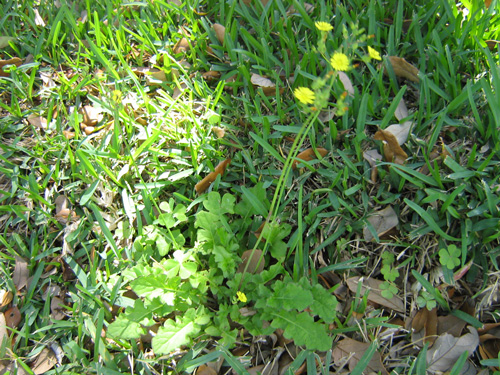 Broadleaf
Plantain - Plantago rugelii
and Plantago major A
perennial rosette reproducing
from seed. Leaves are large,
rounded and deeply veined with
wavy edges and purple petioles.
Seed stems resemble a rat's tail
and support small flowers and
seeds. Long tap root, similar to
Dandelion, increases plants'
hardiness to stress and
herbicides
Broadleaf
Plantain - Plantago rugelii
and Plantago major A
perennial rosette reproducing
from seed. Leaves are large,
rounded and deeply veined with
wavy edges and purple petioles.
Seed stems resemble a rat's tail
and support small flowers and
seeds. Long tap root, similar to
Dandelion, increases plants'
hardiness to stress and
herbicides Bull
Thistle - Cirsium vulgare Bull
thistle is a biennial growing
into a rosette with large,
fleshy, coarsely-toothed spiny
leaves. The second year, a
woody, flowering stalk produces
a few, rose-purple blossoms.
Produces less flowers than
Canada Thistle but all flowers
are fertile.
Bull
Thistle - Cirsium vulgare Bull
thistle is a biennial growing
into a rosette with large,
fleshy, coarsely-toothed spiny
leaves. The second year, a
woody, flowering stalk produces
a few, rose-purple blossoms.
Produces less flowers than
Canada Thistle but all flowers
are fertile. Yellow
Woodsorrel - Oxalis stricta
Annual to short lived perennial,
upright, with single tap root,
spreads by seed. Leaves of
three, heart shaped, pale green
and bitter to taste due to
presense of oxalic acid. Bright
yellow flowers have five petals.
Prolific seed producer, pods
will scatter seed for several
feet when touched.
Yellow
Woodsorrel - Oxalis stricta
Annual to short lived perennial,
upright, with single tap root,
spreads by seed. Leaves of
three, heart shaped, pale green
and bitter to taste due to
presense of oxalic acid. Bright
yellow flowers have five petals.
Prolific seed producer, pods
will scatter seed for several
feet when touched.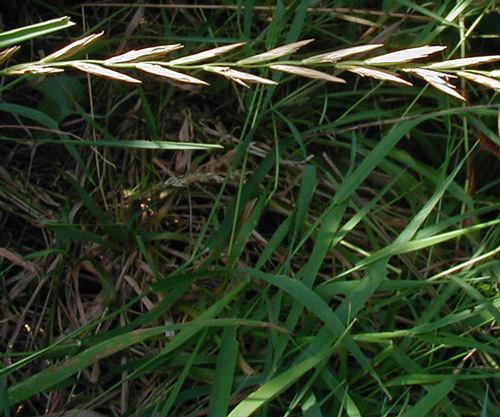 Quackgrass
- Agropyron repens
Quackgrass
- Agropyron repens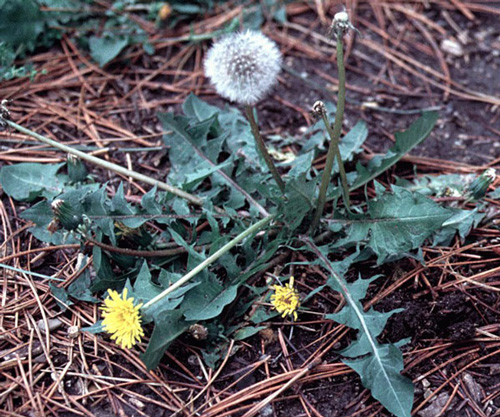 Dandelion
- Taraxacum officnale
Perennial with long tap root
produces by seed. Stems short
arising from a rosette bearing
oblong, lobed, narrow leaves. Large
yellow flowers mature into round
puffballs full of seed distributed
by wind for miles. Mostly germinates
during late summer.
Dandelion
- Taraxacum officnale
Perennial with long tap root
produces by seed. Stems short
arising from a rosette bearing
oblong, lobed, narrow leaves. Large
yellow flowers mature into round
puffballs full of seed distributed
by wind for miles. Mostly germinates
during late summer. Light green,
cool-season
annual grass
bunch type or
clump growth
habit numerous
seeds,
especially in
spring, making
it very
noticeable in
the lawn dies
out during the
heat of the
summer new
seeds begin
germinating late
summer found
throughout the
U.S. apply
crabgrass
preventer before
annual bluegrass
begins
germination in
late summer
Light green,
cool-season
annual grass
bunch type or
clump growth
habit numerous
seeds,
especially in
spring, making
it very
noticeable in
the lawn dies
out during the
heat of the
summer new
seeds begin
germinating late
summer found
throughout the
U.S. apply
crabgrass
preventer before
annual bluegrass
begins
germination in
late summer
 Vining habit,
with extensive
root system
very persistent
shades out
lawn will
climb on nearby
flowers and
shrubs
Vining habit,
with extensive
root system
very persistent
shades out
lawn will
climb on nearby
flowers and
shrubs
 Very common in
new lawns
sprouts and
grows in cool
weather
Very common in
new lawns
sprouts and
grows in cool
weather
 Often indicates
poor soil, need
for fertilizer
appears in cool
weather
Often indicates
poor soil, need
for fertilizer
appears in cool
weather
 Seeds sprout in
spring and
summer after
rain or watering
very fast
growing likes
bare and weak
areas of the
lawn
Seeds sprout in
spring and
summer after
rain or watering
very fast
growing likes
bare and weak
areas of the
lawn
 Persistent
invasive, forms
a mat that
chokes and
shades grass
most prevalent
in moist soil
and partial
shade, but also
thrives in sun
Persistent
invasive, forms
a mat that
chokes and
shades grass
most prevalent
in moist soil
and partial
shade, but also
thrives in sun
 Appears in
summer, but
grows year-round
in warm climates
thrives in
low, wet areas
Appears in
summer, but
grows year-round
in warm climates
thrives in
low, wet areas
 Persistent
appears in early
spring and
continues
through summer
and fall, or
year-round in
warm climates
will adapt
height to escape
mowing
Persistent
appears in early
spring and
continues
through summer
and fall, or
year-round in
warm climates
will adapt
height to escape
mowing
 Creeps and
spreads through
lawn to choke it
out one
species is used
as a substitute
for grass in
some West Coast
areas
Creeps and
spreads through
lawn to choke it
out one
species is used
as a substitute
for grass in
some West Coast
areas
 Similar in
appearance to
Crabgrass,
except base of
stems are
lighter green
and Goosegrass
appears weeks
later very
strong roots;
hard to pull
out-competes
lawn in hot, dry
conditions
Similar in
appearance to
Crabgrass,
except base of
stems are
lighter green
and Goosegrass
appears weeks
later very
strong roots;
hard to pull
out-competes
lawn in hot, dry
conditions
 Sprouts in fall
and grows during
cool season
prefers rich,
moist soil and
partial shade
invades bare or
weak areas of
lawn
Sprouts in fall
and grows during
cool season
prefers rich,
moist soil and
partial shade
invades bare or
weak areas of
lawn
 Common in grass
where soil is
compacted
Common in grass
where soil is
compacted
 Low-growing,
prostrate winter
annual with
hard-to-see but
easily felt
spine-tipped
burs hence the
common name
found in the
Southeast &
along the
Pacific Coast
apply weed
killer in late
fall to late
winter
Low-growing,
prostrate winter
annual with
hard-to-see but
easily felt
spine-tipped
burs hence the
common name
found in the
Southeast &
along the
Pacific Coast
apply weed
killer in late
fall to late
winter
 Most common in
damp, compacted
soil very
persistent
forms colonies
by seeds and
underground
nut-like corns
Most common in
damp, compacted
soil very
persistent
forms colonies
by seeds and
underground
nut-like corns
 Persistent
grows best in
cool season
Persistent
grows best in
cool season
 Found in moist
soil, shade
spreads by
seeding
appears in
spring and
continues
through summer
broadleaf
plantain common
in wet,
compacted soil
Found in moist
soil, shade
spreads by
seeding
appears in
spring and
continues
through summer
broadleaf
plantain common
in wet,
compacted soil
 Painful if
stepped on
often flat and
hidden in the
grass spreads
quickly by
seeding
appears in
spring and
continues till
fall
Painful if
stepped on
often flat and
hidden in the
grass spreads
quickly by
seeding
appears in
spring and
continues till
fall
 Makes a mat that
chokes lawn
likes rich soil
spreads
quickly from
seed
Makes a mat that
chokes lawn
likes rich soil
spreads
quickly from
seed
 Appears in
spring and
remains through
fall painful
to step on the
spiny "bur," or
seed spreads
quickly from
seed worst in
sandy soils
Appears in
spring and
remains through
fall painful
to step on the
spiny "bur," or
seed spreads
quickly from
seed worst in
sandy soils
 Dainty runners
grow into a
solid sheet that
chokes grass
clippings
scattered by
mower root where
they land
Dainty runners
grow into a
solid sheet that
chokes grass
clippings
scattered by
mower root where
they land
 Appears in
spring and
summer prefers
sunny areas
forms a stiff
mat that chokes
and shades grass
Appears in
spring and
summer prefers
sunny areas
forms a stiff
mat that chokes
and shades grass
 Appears in cool
weather
sprouts here and
there, but can
spread if
uncontrolled
ruins the look
of a uniform
winter carpet in
warm-season
lawns
Appears in cool
weather
sprouts here and
there, but can
spread if
uncontrolled
ruins the look
of a uniform
winter carpet in
warm-season
lawns
 Appears in late
winter mars
the uniform look
of winter lawn
persistent,
smells like
onion waxy
coating protects
leaves from
spray step on
leaves to crush
lightly before
spraying
Appears in late
winter mars
the uniform look
of winter lawn
persistent,
smells like
onion waxy
coating protects
leaves from
spray step on
leaves to crush
lightly before
spraying



